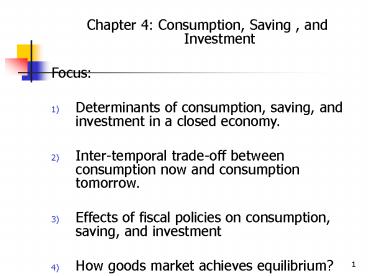Chapter 4: Consumption, Saving , and Investment - PowerPoint PPT Presentation
Title:
Chapter 4: Consumption, Saving , and Investment
Description:
User Cost of Capital = real rate of interest depreciation ... Net Investment = Gross Investment -Depreciation. Kt 1 Kt = It - dkt. 8 ... – PowerPoint PPT presentation
Number of Views:1122
Avg rating:3.0/5.0
Title: Chapter 4: Consumption, Saving , and Investment
1
- Chapter 4 Consumption, Saving , and Investment
- Focus
- Determinants of consumption, saving, and
investment in a closed economy. - Inter-temporal trade-off between consumption now
and consumption tomorrow. - Effects of fiscal policies on consumption,
saving, and investment - How goods market achieves equilibrium?
2
- Consumption
- The decision to consume is equivalent to decision
to save (negative consumption). - Main Determinants of Consumption (Saving)
- Real Rate of Interest
- Current Income
- Future Income
- Wealth
3
- The real rate of interest determines the cost of
todays consumption in terms future consumption
forgone. - Consumption-smoothing motive The desire to have
even (or flat) pattern of consumption over time. - We assume that individuals have
Consumption-smoothing motive. - Marginal Propensity to Consume (MPC) Increase in
consumption for a unit increase in income.
4
- The Substitution Effect of the Real Rate of
Interest The tendency to reduce the current
consumption when the real rate of interest rises.
- The Income Effect of the Real Rate of Interest
The tendency to increase the current consumption
when the real rate of interest rises. - These two effects have opposite effect on the
current consumption of a saver. - In the case of a borrower, these two effects
reinforce each other and reduce the current
consumption.
5
- Any change in current taxes, holding current and
future government expenditure constant, does not
affect desired consumption and saving. This is
called the Ricardian Equivalence Proposition. - The Ricardian Equivalence Proposition holds only
when consumers take into account offsetting
changes in future taxes. - In the case this assumption does not hold, higher
current taxes reduces desired current consumption
and increases the desired saving. - Any increase in the government expenditure (G)
reduces the desired level of consumption and
saving.
6
- Investment
- While making investment firms compare the cost of
making investment (real rate of interest
depreciation) with the benefit of investment
(expected MPK). - Desired capital stock Amount of capital that
maximizes the expected profit. - User Cost of Capital real rate of interest
depreciation - The desired stock of capital is determined by the
condition - User cost (uc) Expected MPK (MPKf)
7
- In the case, the government imposes tax on
output, the desired capital stock is given by the
condition - (1 tax rate ) MPKf uc
- Or, MPKf (uc/(1-tax rate))
- Capital stock and investment satisfy following
identity - Net Investment Gross Investment -Depreciation
- Kt1 Kt It - dkt
8
- If the desired capital stock (Kt) is same as the
actual capital stock, then we have - It Kt1 Kt dkt
- For making investment in inventories and housing
as well, one compares the cost of investment with
the benefit of investment.
9
- Goods Market Equilibrium
- The equilibrium in goods market is given by the
condition that supply of goods and services
equals demand for goods and services - Y Cd Id G
- Or, Y - Cd G Id
- Or, Sd Id































